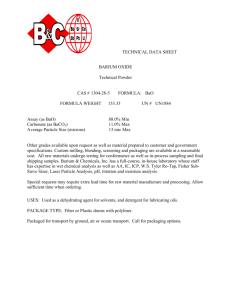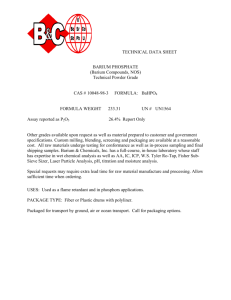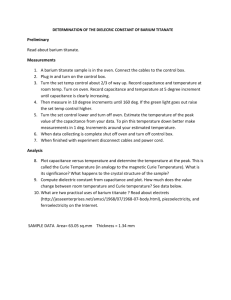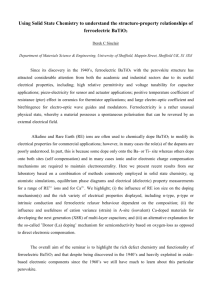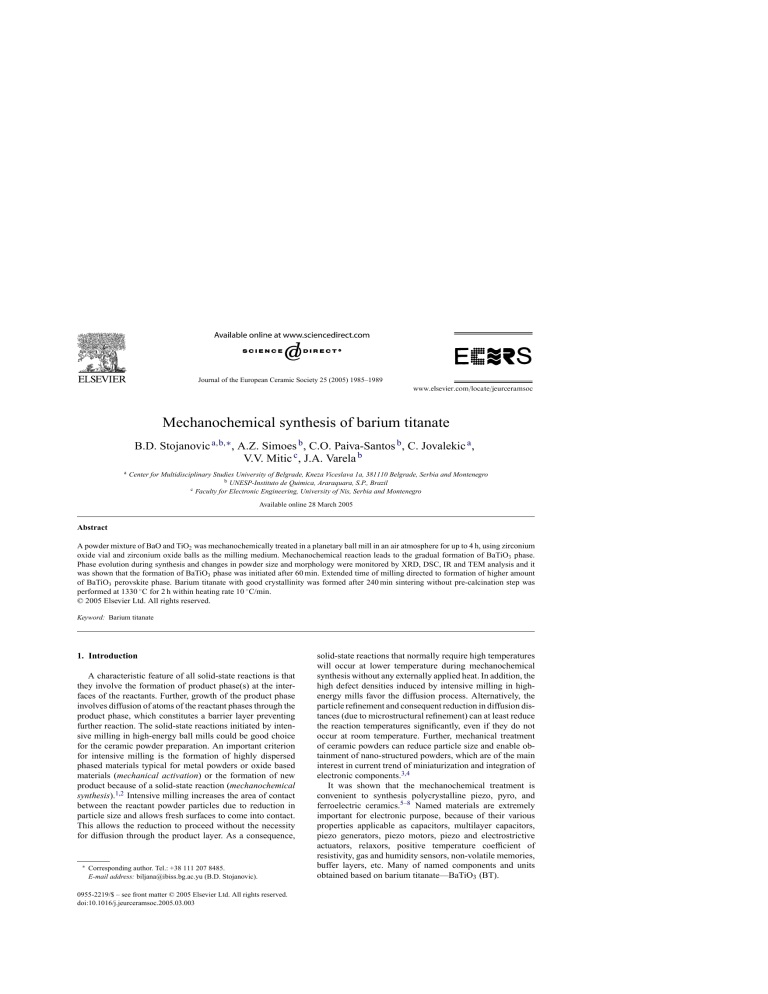
Journal of the European Ceramic Society 25 (2005) 1985–1989
Mechanochemical synthesis of barium titanate
B.D. Stojanovic a,b,∗ , A.Z. Simoes b , C.O. Paiva-Santos b , C. Jovalekic a ,
V.V. Mitic c , J.A. Varela b
a
Center for Multidisciplinary Studies University of Belgrade, Kneza Viceslava 1a, 381110 Belgrade, Serbia and Montenegro
b UNESP-Instituto de Quimica, Araraquara, S.P., Brazil
c Faculty for Electronic Engineering, University of Nis, Serbia and Montenegro
Available online 28 March 2005
Abstract
A powder mixture of BaO and TiO2 was mechanochemically treated in a planetary ball mill in an air atmosphere for up to 4 h, using zirconium
oxide vial and zirconium oxide balls as the milling medium. Mechanochemical reaction leads to the gradual formation of BaTiO3 phase.
Phase evolution during synthesis and changes in powder size and morphology were monitored by XRD, DSC, IR and TEM analysis and it
was shown that the formation of BaTiO3 phase was initiated after 60 min. Extended time of milling directed to formation of higher amount
of BaTiO3 perovskite phase. Barium titanate with good crystallinity was formed after 240 min sintering without pre-calcination step was
performed at 1330 ◦ C for 2 h within heating rate 10 ◦ C/min.
© 2005 Elsevier Ltd. All rights reserved.
Keyword: Barium titanate
1. Introduction
A characteristic feature of all solid-state reactions is that
they involve the formation of product phase(s) at the interfaces of the reactants. Further, growth of the product phase
involves diffusion of atoms of the reactant phases through the
product phase, which constitutes a barrier layer preventing
further reaction. The solid-state reactions initiated by intensive milling in high-energy ball mills could be good choice
for the ceramic powder preparation. An important criterion
for intensive milling is the formation of highly dispersed
phased materials typical for metal powders or oxide based
materials (mechanical activation) or the formation of new
product because of a solid-state reaction (mechanochemical
synthesis).1,2 Intensive milling increases the area of contact
between the reactant powder particles due to reduction in
particle size and allows fresh surfaces to come into contact.
This allows the reduction to proceed without the necessity
for diffusion through the product layer. As a consequence,
∗
Corresponding author. Tel.: +38 111 207 8485.
E-mail address: biljana@ibiss.bg.ac.yu (B.D. Stojanovic).
0955-2219/$ – see front matter © 2005 Elsevier Ltd. All rights reserved.
doi:10.1016/j.jeurceramsoc.2005.03.003
solid-state reactions that normally require high temperatures
will occur at lower temperature during mechanochemical
synthesis without any externally applied heat. In addition, the
high defect densities induced by intensive milling in highenergy mills favor the diffusion process. Alternatively, the
particle refinement and consequent reduction in diffusion distances (due to microstructural refinement) can at least reduce
the reaction temperatures significantly, even if they do not
occur at room temperature. Further, mechanical treatment
of ceramic powders can reduce particle size and enable obtainment of nano-structured powders, which are of the main
interest in current trend of miniaturization and integration of
electronic components.3,4
It was shown that the mechanochemical treatment is
convenient to synthesis polycrystalline piezo, pyro, and
ferroelectric ceramics.5–8 Named materials are extremely
important for electronic purpose, because of their various
properties applicable as capacitors, multilayer capacitors,
piezo generators, piezo motors, piezo and electrostrictive
actuators, relaxors, positive temperature coefficient of
resistivity, gas and humidity sensors, non-volatile memories,
buffer layers, etc. Many of named components and units
obtained based on barium titanate—BaTiO3 (BT).
1986
B.D. Stojanovic et al. / Journal of the European Ceramic Society 25 (2005) 1985–1989
Progress in processing of materials fabricated on the basis of BT both at the powder synthesis stage and subsequent
densification to solid component is caused by increasing demands on the quality of the electronic ceramics. Sintering
process is generally improved by liquid phase sintering with
titanium reach composition at the temperature above 1320 ◦ C
or by mechanical activation of initial powders BaCO3 and
TiO2 .9–15
It was noticeable that the processing during mechanical
activation of BT lead to increase in specific surface area, as
a consequence of destruction of agglomerates and the particles of the starting materials. XRD analysis of mechanically
activated powders was shown the small amount of perovskite
phase; however after calcination the perovskite cubic phase
of BaTiO3 increases with increase of activation time. Gomez
et al.12 analyzed the effect of long-term milling up to 78 h in
an attritor on the structure and chemical behavior of the initial
constituents BaCO3 and TiO2. It was shown that mechanical
activation accelerated the formation rate of BaTiO3 . Otherwise, long term-milling provoked the formation of Ba2 TiO4
besides BT phase. Welham obtained BaTiO3 as a result of
the milling of BaO + TiO2 in a ball mill during 100 h, however high temperature treatments were needed to preserve the
BaO in pure state, prior to the milling.16 Abe and Suzuki using the milling in the planetary ball mill and starting from the
mixture of Ba(OH)2 ·8H2 O + TiO2 obtained a BaTiO3 powder
which had poor crystallinity, so an annealing treatment was
necessary.11 Milling of the mixture of powders of Ba + Ti
constituents followed by an oxidation heat treatment in an
atmosphere of pure oxygen gave also BaTiO3 as product.
Evidently, the formation of perovskite phase of BT occurs
during thermal treatment slightly lower after mechanical activation of initial powders. On the other hand, the mechanical
activation could be associated with the formation of transient
phases formed during grinding.
In view of above, our paper reports on work carried out on
fine BaTiO3 powders synthesized via the mechanical activation of BaO2 and TiO2 directly during high-energy milling.
The resulting BaTiO3 powders have been evaluated for powder characteristic.
2. Experimental procedure
The barium titanate was prepared starting from barium oxide (BaO) and titanium oxide. TiO2 , in a rutile crystal form
was commercially available (Fluka, 99.8% purity). BaO was
obtained from BaCO3 thermally treated at 1300 ◦ C for 4 h
to complete decomposition of carbonates to oxides controlling the carbonate presence. These oxide powders exhibited
a particle size distribution in the range 2–4 m for TiO2 and
1–5 m for BaO. To make a batch required for stoichiometric BaTiO3 composition, corresponding amount of prepared
BaO and TiO2 were weighed and loaded into zirconium jars
together with zirconium milling balls ∼10 mm in diameter.
Mechanical activation, i.e. mechanochemical synthesis was
performed in air atmosphere in a planetary ball mill (Fritsch
Pulverisette 5) that was operated at basic disc rotation speed
320 min−1 and rotation speed of discs with jars ∼400 rpm
for 30, 60, 120 and 240 min. The relation between powders and balls during milling was 1:20. Phase development
in the mechanically activated powders was monitored using an X-ray difractometer (XRD, Model D500, Siemens)
and using DSC (Model STA 409 Netzsch) and DTA-TG
analysis (Model 414/2, TASC). Transmission electron microscopy (TEM, Model 213, Philips) and scanning electron
microscopy (SEM, Model SM-300, Topcon) were used to
study their particle size and powder morphology. Infrared
spectroscopy (Model 400-IR/FT, IMPACT) was used to indicate the presence of carbonates in barium titanate powders.
3. Results and discussion
It is well known that multiple advantages of the solid-state
method for preparing BaTiO3 are that it is a single process and
a low cost technique. Despite the advantages, there are some
problems to be solved. The high calcination temperatures
lead to coarsening of the BaTiO3 particles that are unsuitable
for manufacturing fine grained ceramics and that, even the
nominal ratio Ba/Ti in starting materials is 1, intermediate
phases or BaCO3 can persist as an end-product preventing to
complete reaction between the starting materials. Otherwise,
it was established that the barium titanate ceramic materials
and its solid solutions may be prepared directly during highenergy milling or at low calcination temperatures as the result
of physical, chemical and physico-chemical changes due to
influence of mechanical energy. It means that the formation of
perovskite phase of BT occurs slightly easier after mechanical
activation of initial powders. Also, lowering the calcination
temperature could prevent anomalous grain growth.9
Practically all known papers are devoted to investigations
of mechanical activation of BaCO3 and TiO2 and only few
articles are addressed to mechanical synthesis of this material
from oxides milling in nitrogen atmosphere. According to the
same literature data when the mixed oxides of BaO and TiO2
were mechanically activated in air, the formation of BaCO3
was triggered and the formation of perovskite BaTiO3 phase
could not be realized.16
In spite of those observations, our intention was to prepare
barium titanate by milling in air atmosphere starting from
oxides. In order to obtain barium titanate by mechanical activation of BaO2 and TiO2 in air atmosphere, we used milling
in a planetary ball mill during various time of mechanical
activation. As one would expect, the formation of barium titanate was detected by XRD analysis. Fig. 1a–g shows the
XRD patterns for initial powders BaO2 (a) and TiO2 in the rutile crystal form (b) and diffractograms for powders that have
been mechanically activated for various time periods: 30, 60,
120 and 240 min ((c)–(f)). Certain amount of perovskite cubic BaTiO3 , indicated by the peaks at 2θ angles at 22.0◦ ,
31.4◦ , 38.7◦ , 45.0◦ , 55.9◦ and 65.5◦ was observed together
B.D. Stojanovic et al. / Journal of the European Ceramic Society 25 (2005) 1985–1989
1987
Fig. 1. X-ray diffraction patterns of initial powders: BaO2 , TiO2 rutile, and
mechanically activated powders at 0, 30, 60, 180 and 240 min.
with the much-weakened and broadened peaks of TiO2 and
BaO. The presence of unreacted components is more evident
when the powder mixture was subjected to mechanical activation for shorter time. Thus, the observation indicates that the
formation of small amount of amorphous BaTiO3 phase triggers after 60 min of mechanical activation. Therefore, besides
rather amorphous phase of barium titanate, the peak broadening of initial oxides implies that shorter time of mechanical
activation is not enough to obtain good crystallinity of pure
BaTiO3 . A degree of amorphization decreased with extended
time of mechanical activation and after 240 min only a minor
amount of initial oxides is still observed. In this case, we can
see the effectiveness of the milling process.
It is necessary to emphasize that it was observed the presence of visible amount of BaCO3 triggered unless of two main
reasons. First, initial barium oxide was not used as a fresh prepared constituent. Taking this in account, the probability of
barium carbonate formation is rather high and the XRD analysis of initial barium oxide (Fig. 1a) confirmed this observation. Besides, during milling in air atmosphere, the formation
of BaCO3 could be effected. Meanwhile, during extended
time of milling, besides possibility of phase transformation
of ␥-BaCO3 in ␣-BaCO3, the decomposition of carbonate to
oxide is facilitated favoring after the mechanochemical reaction. By IR analysis was confirmed the presence of small
amount of BaCO3 even the powder was mechanochemically
activated 240 min (Fig. 2).
Comparison DSC curves (Fig. 3) of 30 and 240 min
mechanically activated mixtures helps to establish the
influence of mechanical activation on solid-state reaction
and phase formation of barium titanate. Obviously, the
time of mechanical activation has strong influence on the
process. The endothermic hump in the range 400–700 ◦ C
associated with the stronger endothermic thermal peak and
recorded in the powder milled for shorter time coincides to
allotropic transition of BaCO3 and thermal decomposition
of carbonates. Other event observed at ∼1000 ◦ C could
be pertaining to solid-state reaction between oxides and
formation of barium titanate. Comparing with XRD results
Fig. 2. IR measurement carried out on a 240 min mechanically activated
barium titanate sample.
seems that barium titanate was formed only to a limited
extend. The DSC curve for extended milling time within the
same temperature range did not show any distinctive event.
Otherwise, after 240 min of mechanical activation, the barium titanate phase as the major ones seems to have been only
formed.
The morphology of the barium titanate powder after
mechanical activation is presented in Fig. 4. It is possible
to identify the rather strong agglomeration of powders
after milling time of 240 min. BaTiO3 powder consists of
agglomerates of varying size and morphology. A detailed
study at high magnifications showed that agglomerate
consists from approximately 100 grains with grains mostly
rounded shaped in the range 20–50 nm. Nanoparticles are
observed clearly, although they have aggregated together
to form irregularly shaped agglomerates. The needle like
Fig. 3. DSC curves of samples prepared from powders mechanically activated at 30 and 240 min.
1988
B.D. Stojanovic et al. / Journal of the European Ceramic Society 25 (2005) 1985–1989
4. Conclusion
Using mixed oxides BaO and TiO2 as the staring materials, the formation of singe phase BaTiO3 compound could
be obtained during mechanical activation. The formation of
BaTiO3 in air besides small amount of BaCO3 was possible
to trigger pointing to solid-state reaction occurrence during
intensive milling. The nucleation of nanocristallites and subsequent growth of a highly activated oxide matrix forming
a substantial amount of BaTiO3 phase increased with an increasing degree of mechanochemical synthesis. The amount
of carbonates was minimized during extended milling time.
The resulting perovskite BaTiO3 powder exhibited a particle
size in the range of 20–50 nm. Mechanochemically synthesized BaTiO3 powder was rather agglomerated after 240 min
of milling in planetary ball-mill. After sintering, tetragonal
structure of barium titanate was obtained.
Acknowledgements
Fig. 4. TEM of barium titanate powders mechanically activated 240 min.
grains were not observed in mechanically activated powders
indicating that Ba2 TiO4 phase was not formed and what was
in agreement with XRD results.
The effect of mechanochemical activation can be detected
after carrying out thermal treatments on the samples. For example, samples prepared from 240 min of mechanical activation and sintered at 1330 ◦ C for 2 h, without pre-calcination
step, possess clear tetragonal crystal structure of barium titanate (Fig. 5).
Fig. 5. XRD powder patterns obtained on sample sintered at 1330 ◦ C for 2 h
and prepared from mechanically activated powders for 240 min.
This research is the part of the projects:
(a)“Synthesis of functional materials according to tetrad:
synthesis–structure–properties–application” (No. 1832)
and (b) Brazilian thematic projects. The authors gratefully
acknowledge the financial support of Serbian Ministry
for Science and Environmental Protection and Brazilian
foundations CnPq and FAPESP.
References
1. Wang, J., Wan, D. W., Xue, J. M. and Ng, W. B., Novel
Mechanochemical Fabrication of Electroceramics. Singapore Patent
9801566-2, 1998.
2. Xue, J., Wan, D., Lee, S. E. and Wang, J., Mechanochemical synthesis
of nanosized lead titanate powders from mixed oxides. J. Am. Ceram.
Soc., 1999, 82(7), 1687–1692.
3. Ding, J., Ssuzuki, T. and Mc Cormic, P. G., Ultrafine particles prepared by mechanical/thermal processing. J. Am. Ceram. Soc., 1996,
79, 2956–2958.
4. Giri, A. K., Nanocrystalline materials prepared through crystallization
due to instability in amorphous materials after grinding. Adv. Mater.,
1997, 9, 163–166.
5. Boldyrev, V. V., Mechanochemistry and mechanical activation. Mater.
Sci. Forum, 1996, 227, 511–520.
6. Gaffet, E., Michael, D., Mazerolles, L. and Berthet, P., Effect of
high-energy ball-milling on ceramic oxides. Mater. Sci. Forum, 1997,
235–238(1), 103–108.
7. Francoise, D. M., Gaffet, E. and Mazerolles, L., Stabilized zircons
prepared by mechanical activation. J. Am. Ceram. Soc., 1993, 76,
2884–2888.
8. Komattsubara, S., Isobe, T. and Senna, M., Effect of preliminary
mechanical treatment on the microhomogenization during heating of
hydrous gels as precursors for lead titanate. J. Am. Ceram. Soc., 1994,
772, 278–282.
9. Kostic, E. M., Kiss, S. J., Boskovic, S. B. and Zec, S. P., Mechanical
activation of titanium oxide. Am. Ceram. Soc. Bull., 1997, 76, 60–64.
10. Stojanovic, B. D., Pavlovic V. B., Marinkovic, B. and Ristic, M. M.,
Influence of tribophysical activation on structure and properties of
BaTiO3 ceramics. In Book of abstracts CIMTEC’98, ed. P. Vincenzini
and G. Galeati. Florence, 1998, pp. 40–41.
B.D. Stojanovic et al. / Journal of the European Ceramic Society 25 (2005) 1985–1989
11. Abe, O. and Suzuki, Y., Mechanochemically assisted preparation of
BaTiO3 powders. Mater. Sci. Forum, 1996, 225, 563–568.
12. Gomez-Yanez, C., Benitez, C. and Ramirez, H. B., Mechanical activation of the synthesis reaction of BaTiO3 from a mixture of BaCO3
and TiO2 powders. Ceram. Int., 2000, 26, 271–277.
13. Randall, C. A., Kim, N. J., Kucera, P., Cao, W. W. and Shrout, T.
R., Intrinsic and extrinsic size effects in fine-grained lead-zirconate
titanate ceramics. J. Am. Ceram. Soc., 1992, 71, 978–985.
1989
14. Berbenni, V., Marini, A. and Bruni, G., Effect of mechanical milling
on solid state formation of BaTiO3 from BaCO3 –TiO2 rutile. Thermochim. Acta, 2001, 374, 151–158.
15. Brzozovski, E. and Castro, M. A., Lowering the synthesis temperature
of high-purity BaTiO3 powders by modifications in the processing
conditions. Thermochim. Acta, 2003, 398, 123–129.
16. Xue, J., Wang, J. and Wan, D., Nanosized barium titanate powder by
mechanical activation. J. Am. Ceram. Soc., 2002, 83(19), 232–234.

